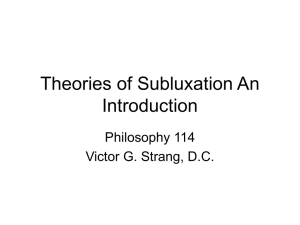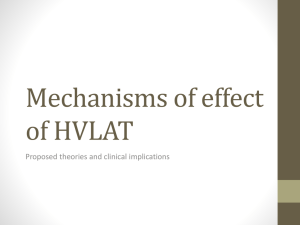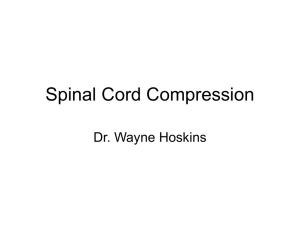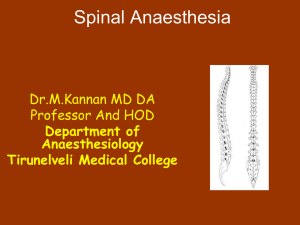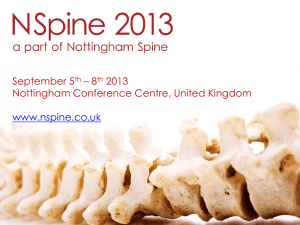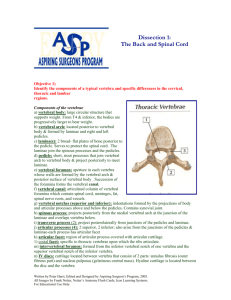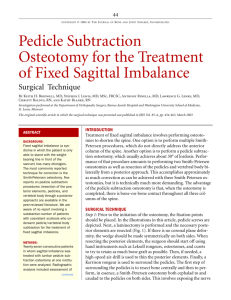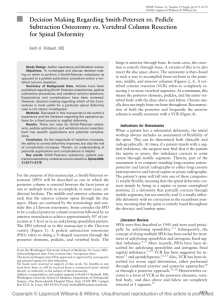We positioned patients on the OSI (Orthopedic Systems Inc
advertisement
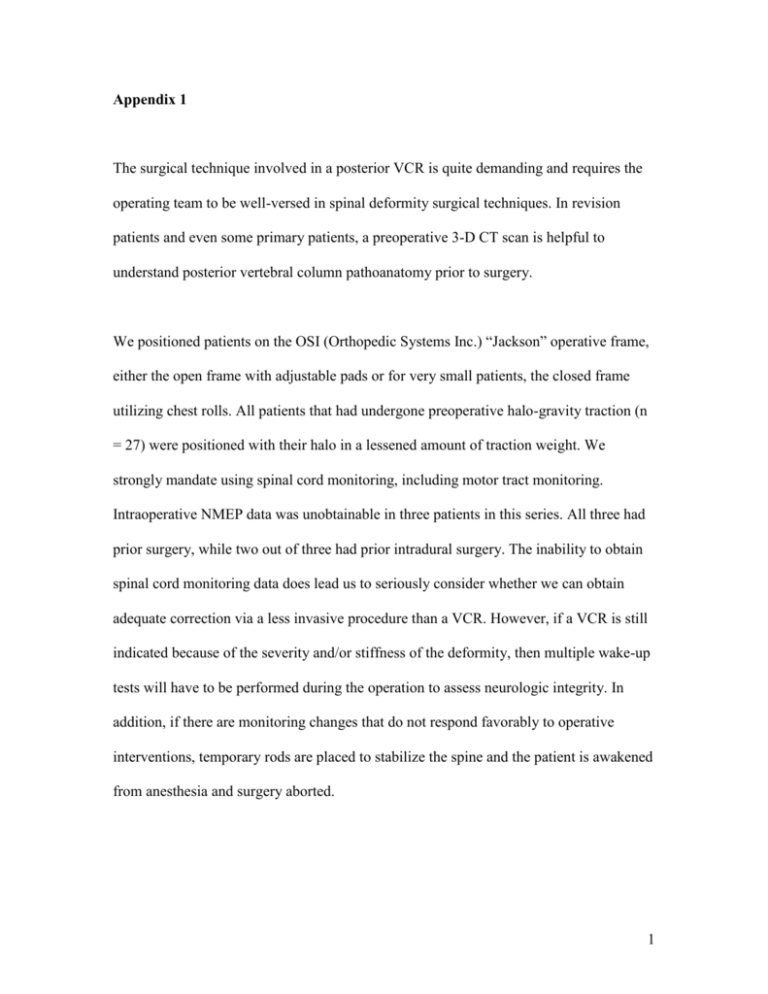
Appendix 1 The surgical technique involved in a posterior VCR is quite demanding and requires the operating team to be well-versed in spinal deformity surgical techniques. In revision patients and even some primary patients, a preoperative 3-D CT scan is helpful to understand posterior vertebral column pathoanatomy prior to surgery. We positioned patients on the OSI (Orthopedic Systems Inc.) “Jackson” operative frame, either the open frame with adjustable pads or for very small patients, the closed frame utilizing chest rolls. All patients that had undergone preoperative halo-gravity traction (n = 27) were positioned with their halo in a lessened amount of traction weight. We strongly mandate using spinal cord monitoring, including motor tract monitoring. Intraoperative NMEP data was unobtainable in three patients in this series. All three had prior surgery, while two out of three had prior intradural surgery. The inability to obtain spinal cord monitoring data does lead us to seriously consider whether we can obtain adequate correction via a less invasive procedure than a VCR. However, if a VCR is still indicated because of the severity and/or stiffness of the deformity, then multiple wake-up tests will have to be performed during the operation to assess neurologic integrity. In addition, if there are monitoring changes that do not respond favorably to operative interventions, temporary rods are placed to stabilize the spine and the patient is awakened from anesthesia and surgery aborted. 1 Because of the length of these surgeries and the potential for substantial bleeding, we believe it imperative to minimize blood loss during these surgeries. This is performed not only with careful subperiosteal stripping of the posterior vertebral elements, but also with the use of adjunctive antifibrinolytics such as aprotinin (Trasylol, Bayer HealthCare Pharmaceuticals, Montville, NJ) or tranexamic acid. We used aprotinin in all pediatric patients (n = 31) during their procedure. While the use in adults was initially performed, it is no longer administered to any patient due to the risk of renal failure as recently documented in the cardiac literature [14]. One surgeon (LGL) performed all surgeries in this series. Following exposure, we performed posterior column ligament and facet releases/osteotomies (Ponté-type osteotomies in previously unfused spines and Smith-Petersen osteotomies in previously fused regions) [4]. These often were performed at the apex of scoliosis or kyphoscoliosis deformities to provide additional release and also to aid in apical pedicle screw fixation. Secure pedicle screw fixation was then obtained for the appropriate levels to be included in the definitive instrumentation and fusion. Pedicle fixation provided stability to the spinal column above and below the resection area, which is imperative in preventing and/or treating spinal subluxation which is a real risk with these procedures. All pedicle screws in this series were placed using the free hand technique espoused by Kim and Lenke et al using anatomic landmarks and a special blunt, curved gearshift [9]. In the thoracic spine, we removed 5 to 6 cm of the medial rib associated with the level to be resected prior to the laminectomy to avoid canal intrusion. In primary procedures, 2 dissection above the periosteum and around the lateral aspect of the pedicles and vertebral body was performed using Penfield elevators. We held the soft tissues and the anterior vasculature from harm’s way with either malleable retractors or special lateral wall vertebral body elevators (pedicle subtraction osteotomy (PSO) tool set®, Medtronic Spinal and Biologics, Memphis, TN). In revision cases, a subperiosteal dissection was performed due to previous scarring, with a similar approach in order to gain circumferential access to the vertebra(e) to be resected. In both circumstances, the segmental vessels were kept lateral in a soft tissue cuff and were not violated. We then performed a wide laminectomy centrally over the apical level(s) to be resected. Typically, the entire lamina of the level to be resected was removed, the lamina cephalad to the pedicles above and caudad to the pedicles below. Normally for a one-level resection, a posterior column laminectomy will result in a 4 to 5 cm exposure of the dura and neural elements. Next, we encircled the pedicles to be resected and began removal of the vertebral body. Prior to removing the anterior body, a temporary, stabilizing rod was placed and attached to at least two or three pedicle screws both above and below the resection area. In most deformities a unilateral rod was used, but for severe angular kyphotic or kyphoscoliotic deformities, we recommend bilateral rods to prevent spinal subluxation. The vertebral body resection began by gaining access to the cancellous bone of the vertebral body through a lateral pedicle-body entrance. Next, we curetted the cancellous bone of the body, saving it for bone graft. For a scoliosis or kyphoscoliosis deformity, resecting the apical concave pedicle can be quite challenging since it is cortical, and in a pure scoliosis deformity, the entire spinal cord/dural sac is resting on the 3 medial concave pedicle. We therefore use a small high-speed burr (we prefer the Midas Rex® AM8 [Medtronic, Fort Worth, TX]) to carefully burr away the cortical bone along this concave region. We prefer to perform the concave resection of the pedicle prior to the convex removal so there is no bleeding into this dependent concave region. This also allows the concave spinal cord to drift somewhat more medial and remove tension prior to going to the convexity for completion of the corpectomy. We removed the entire body except for the anterior shell to keep a thin rim of bone intact on the anterior longitudinal ligament (ALL) for fusion. We then performed discectomies above and below using curettes. The last part of the vertebra to be resected was the posterior vertebral body wall or floor of the spinal canal. Here it is essential to control epidural bleeding with the judicious use of bipolar cauterization, topical hemostatic agents such as FloSeal® (Baxter U.S., Deerfield, IL), Gelfoam® (Pharmacia, Kalamazoo, MI), and cottonoids. This posterior vertebral wall must be removed in its entirety; we used reverse-angled curettes, Woodson elevators, or a specialized posterior wall impactor (PSO tool set®, Medtronic Spinal and Biologics, Memphis, TN) to impale the posterior wall into the ventral defect that had been created. It is imperative that the ventral spinal cord is completely free of any bony prominences to avoid impingement during closure. This is especially true at the disc levels, specifically above but also below, as there tends to be osteophytic lipping in that region which can cause ventral cord compression if not removed. 4 The spinal column was always shortened, not lengthened, with convex compression performed as the main correcting technique. This was accomplished either with individual pedicle screws in primary cases where a good bony grip of the vertebrae was found, or in a construct-to-construct closure mechanism utilizing dominoes at the apex of the resected area. It is imperative to compress slowly as subluxation and/or dural impingement can occur at any time. In any deformity that has a degree of kyphosis (GK, AK and KS), we placed an anteriorly based structural cage to prevent over-shortening of the deformity and to act as a hinge to provide further kyphosis correction. Following closure of the deformity and shortening by approximately 1.5 to 2 cm, appropriate cage templates are utilized to place a slightly loose cage into the anterior column so there is 1 to 2 mm of space between the inferior and superior endplates above and below the cage. Further compression is performed posteriorly to lock the cage and pivot on it as well. Once closure was completed, we implanted a permanent contralateral rod with appropriate correction maneuvers. The temporary closing rod was then removed and a permanent, final rod placed on the contralateral side. Appropriate compression and distraction forces, in situ contouring, and other correction techniques may be performed always being mindful of any resultant affect on the resected area with respect to subluxation or dural impingement. Next, we confirmed adequate alignment with intraoperative radiographs. We then decorticated the spine and used copious amounts of local graft obtained from the resection procedure. To cover the laminectomy defect, the ribs were split in half longitudinally with the cancellous surface placed along the entire laminectomy defect from the lamina above to the lamina below. This created a rib 5 “bridge” of bone to protect the dura as well as to provide a posterior only fusion. The rib was held in place with sutures or a crosslink if there was room and if it did not create a prominence. To confirm the absence of impingement, we performed a final circumferential check of the exposed dura. Thirty-seven of these procedures were performed in a single stage with the remaining six treated with a two-stage procedure. We feel that one should begin the VCR portion within 5 to 6 hours into the surgical procedure. If this is not the case, then typically we will place temporary rods into the screw fixation points and return another day to complete the VCR procedure. The overall goal is to perform the entire procedure in less than a 10 to 12-hour operative time if this is performed in one setting. 6

